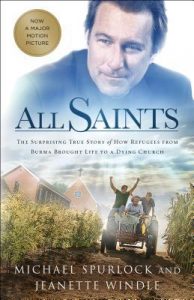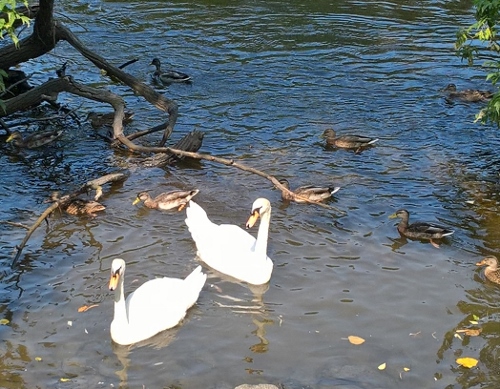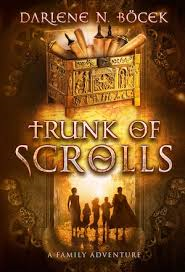At one point I was asked exactly how I recorded my teens’ Canadian history studies for their university admission records. I could see no other way to answer the question than to cut and paste the relevant sections from their comprehensive records, which makes this article incredibly long. Hopefully it will benefit some of you.
I have included 3 examples. Two are very similar and are at the level of Ontario Canadian history course, which is usually taught in grade 10. The other one has Canadian history folded into an intense Western history course and is at a grade 12 level. Notice that even though the courses are all spread over several years, the different readings and emphases make the level different. In all cases, my teens helped decide which texts they used and also selected most of the other books they read.
The reading lists, which I did eventually decide to include in this article, clearly show that these courses cover a span of years. Some of the books are rather simple; others are very intense. It is obvious that these records represent teens who loved to read and, having studied How to Read a Book, knew how to make reading work for them. Please do not be intimidated by them! Every teen is different; the teens represented by these records loved history and that shows in these records (and in the fact that they each did several of such history courses in high school).
You will notice that I wrote the course descriptions in the future tense; this is what seems to be done in high school course catalogues. Of course, I wrote the descriptions after we had decided that particular course was completed, which was helpful because our goals for courses like this change throughout the years. Even so, I tried to keep the descriptions relatively generic. The records themselves follow the format suggested by Lee Binz in Comprehensive Record Solution and Setting the Records Straight.
And, I want to repeat once again, please do not be intimidated by these records and please do not use them as a template for your teen. A reading course like this should be tailored to the student’s interests, so these record-keeping examples are mainly meant to be inspiration for record-keeping. If you and your teen ever plan a course like this, be aware of what is being taught in local public or private schools (often libraries will carry textbooks), and combine that with your teen’s own interests, remembering that a high school credit is somewhere between 100-180 hours of work and that the level of a course can be adjusted by changing the difficulty and amount of readings and the depth of the assignments.
Note:
- I myself did not read each of the books on the lists because there are only 24 hours in the day. On the other hand, because I do try hard to ensure that my teens read suitable books, I did skim many of them.
- My teens were responsible for their own reading records; recording what they had read that week was part of their Friday homeschool assignment.
- For structured courses, like science or French where we followed a textbook, our records are very different.
So, on to the examples:
Example 1: Canadian History
Course Description:
In this reading course, spread over several years, the student will learn about all aspects and times of Canadian history using biographies, historical fiction, textbooks, collections, and monographs. Field trips to museums, discussions with old-timers, research into fashions, and studying the effect of history on current events will all form a part of this course.
Overviews:
Challenge and Survival: The History of Canada by Herstein, Hughes, and Kirbyson
The Story of Canada by Janet Lunn
Famous Canadian Stories by George E. Tait, Ed.
The Upward Trail by George E. Tait
One Dominion by George E. Tait
The Pageant of Canadian History by Anne Merriman Peck
Canada Our Country Part 1 by Aileen Garland
Canada: Portraits of Faith, Ed. Michael D. Clarke
Reading List:
The Refugees: A Tale of Two Continents by Arthur Conan Doyle
The King’s Daughter by J.E. White
My Story: Spy Smuggler by Jim Eldridge
My Story: The Trenches by Jim Eldridge
My Story: The Flying Ace by Jim Eldridge
My Story: The Battle of Britain by Jim Eldridge
Brendan Voyage by Tim Severin
Champlain: Northwest Voyageur by Louise Hall Thorp
The Luck of the La Verendryes by Lyn Harrington
The Talking Wire: The Story of Alexander Graham Bell by O. J. Stevenson
Drummer Boy for Montcalm by Wilma Pitchford Hays
Viking Treasure by Henry Bamman and Robert Whitehead
Roughing it in the Bush, or, Life in Canada by Susanna Moodie
Letters of Love and Duty: The Correspondence of Susanna and John Moodie by Susanna Moodie
Life in the Clearings versus the Bush by Susanna Moodie
The Backwoods of Canada by Catherine Parr Traill
Canadian Wild Flowers by Catherine Parr Traill
The Canadian Settler’s Guide by Catherine Parr Traill
Canadian Crusoes: A Tale of the Rice Lake Plains by Catherine Parr Traill
The Force Carries On by T. Morris Longstreth
Madeleine Takes Command by Ethel C. Brill
Jeremy’s War: 1812 by John Ibbitson
Mary Cook: All of her local history books
Introduction to New France by Marcel Trudel
A Picture History of Canada by Jessie McEwan and Kathleen Moore
More Famous Canadian Stories, Donald G. French, Ed.
Agnes: The Biography of Lady Macdonald by Louise Reynolds
Ordeal by Fire: Canada 1910-1945 by Ralph Allen
Shakedown by Ezra Levant
Beginning Again: Further Adventures of a Loyalist Family by Mary Beacock
Maria Chapdelaine by Louis Hemon
The Sea Captain’s Wife by Beth Powning
I am a Hutterite by Mary-Ann Kirkby
The Discovery of Insulin by Michael Bliss
Flint and Feather by Pauline Johnston
Hudson’s Bay: or Every-day Life in the Wilds of North America by Robert Ballantyne
Grading Criteria:
The final mark will be based on readings, narrations, and discussions. Detailed, accurate knowledge and analyses of events and persons will be expected. Percentages will not be recorded for this course.
Example #2: History of Western Civilization (400 – the Present)
Course Description:
This literature-based, multi-year course, covering the western world from late Roman times until the present, will feature in-depth studies of historical writing. It will emphasize knowledge of ideas, events, and people as well as an understanding of their interrelationships. Special emphasis will be placed on Britain, Canada, and the United States. Readings, tests, reports, projects, and discussions will be key components of the course. Whenever possible the course will include primary source documents, biographies, field trips to museums and historic sites, discussions with old timers and veterans, and documentaries. Studying the effects of history on current events will form part of this course.
Texts:
Omnibus 2: Church Fathers Through the Reformation Edited by Douglas Wilson and G. Tyler Fischer, selections
Omnibus 5: The Medieval World Edited by Gene Edward Veith, Douglas Wilson and G. Tyler Fischer, selections
Omnibus 3: Reformation to the Present Edited by Douglas Wilson and G. Tyler Fischer, selections
Omnibus 6: The Modern World Edited by Gene Edward Veith, Douglas Wilson and G. Tyler Fischer, selections
World History: The Human Odyssey, Jackson J. Spielvogel, ch 7
Supplemental Resources:
Museums: Museum of Civilization, Canadian War Museum, The Canadian Aviation Museum, Diefenbunker: Canada’s Cold War Museum, Canada Science and Technology Museum, Bytown Museum, Goulborne Museum, Watson’s Mill, Upper Canada Village, Heritage Mica Festival and the Silver Queen Mica Mine, Medieval Festival at Upper Canada Village, Fort George,
Film: Documentary series such as Victorian Farm, War Time Farm, and Edwardian Farm, and individual documentaries such as Sisters in the Wilderness and The Queen and the Skipper.
Course Contents:
World History: The Human Odyssey, Jackson J. Spielvogel, ch 7, The Americas (400-1500)
Omnibus 2: Church Fathers Through the Reformation: Confessions by Augustine, Ecclesiastical History by Bede, The Rule of Saint Benedict, Beowulf
Omnibus 5: The Medieval World: The City of God by Augustine, Summa Theologica, selections, by Thomas Aquinas, The Divine Comedy by Dante, The Travels of Marco Polo by Marco Polo, The Prince by Machiavelli, The Institutes, selections, by Calvin, St. Matthew Passion by Bach,
Omnibus 3: Reformation to the Present: Animal Farm by George Orwell, Pilgrim’s Progress by Bunyan, Pride and Prejudice by Austen, Autobiography of Charles G. Finney by Finney, Post-Modern Times by Veith, How Should We Then Live? by Schaeffer
Omnibus 6: The Modern World: Robinson Crusoe by Defoe, Huckleberry Finn by Twain, One Day in the Life of Ivan Denisovich by Alexander Solzhenitsyn, Leaves of Grass by Whitman, Modern Short Stories, Poetry of T. S. Eliot, The Stranger by Camus
Reading List:
As listed under Course Contents, Omnibus 2,5,3,6 above
Note: For Historical Fiction Reading List, see Introduction to World History
Famous Canadian Stories by George E. Tait
The Story of Canada by Janet Lunn and Christopher Moore
Canada: Portraits of Faith, Ed. Michael D. Clarke
More Famous Canadian Stories by Donald G. French
Tomb of Tutankhamen by H. Carter
Prime Ministers of Canada by Jim Lotz
Canada and the First World War by John Swettenham
George Washington’s World by Joanna Foster and Genevieve Foster
Abraham Lincoln’s World by Genevieve Foster and Joanna Foster
The World of Columbus and Sons by Genevieve Foster
The Landmark History of the American People by Daniel J. Boorstin
Indians by Edwin Tunis
El Escoral by Mary Cable
The Song of Roland by James Baldwin
Story of Britain by R.J. Unstead
The Anglo-Saxon Chronicles, selections, translated and compiled by Anne Savage
Luther the Leader by Virgil Robinson
The Rise of Great Britain by R.J. Unstead
Her Majesty the Queen by Hugh Montgomery-Massingberd
Wilderness Mission by John F. Hayes
Bay of the North by Ronald Syme
Champlain by Lourse Hall Tharp
The Loyalists by Christopher Moore
With Pipe, Paddle and Song by Elizabeth Yates
The Luck of the La Verendryes by Lyn Harrington
Augustine Came to Kent by Barbara Willard
The Little Duke or Richard the Fearless by Charlotte Yonge
Stories from the Heart of Canada by Lane
The Life of Charlemagne by Einhart
Salt in His Blood: The Life of Michael De Ruyter by William R. Rang
Saint Patrick by McHugh
O Canada by Karla Akins
Kon-Tiki by Thor Heyerdahl
Sebastian Bach: The Boy from Thuringia by Opal Wheeler and Sybil Deucher
L’Abri by Edith Schaeffer
Little Britches by Ralph Moody
Letters of a Woman Homesteader by Elinor Pruitt Stewart
Man of the Family by Ralph Moody
The Home Ranch by Ralph Moody
Mary Emma and Company by Ralph Moody
The Fields of Home by Ralph Moody
Papa’s Wife by Thyra Ferre Bjorn
Riders of the Pony Express by Ralph Moody
Snow, Stars and Wild Honey by George Morrill
Tracking Marco Polo by Timothy Severin
Photographing Canada from Flying Canoes by S. Bernard Shaw
A Century of Change by R.J. Unstead
Louis Pasteur by Linda W. Smith
The Doctor Who Never Gave Up by Carolynn Scott
War Stories by Gregory Clark
The Children’s Homer by Padraic Colum
The Assault on Reason by Al Gore
Mein Kampf by Adolf Hitler
Going Rogue by Sarah Palin
The Brendan Voyage by Tim Severin
A Soldier First by General Rick Hillier
Vet in a Spin by James Herriot
The Longest Day by Cornelius Ryan
Hitler’s Second Book by Adolf Hitler
Gideon’s Spies by Gordon Thomas
Nickles and Dimes by Nina Brown Baker
Moe Howard and the Three Stooges by Moe Howard
George Alfred Henty by George Manville Fenn
Pigeon Hero by Shirley Ray Redmond
J.R.R. Tolkien by Wayne G. Hammond and Christina Scull
Sadam’s Secrets by Georges Sada
Decision Points by George W. Bush
America by Heart by Sarah Palin
J.R.R. Tolkien by Humphrey Carpenter
Politically Incorrect Guide to Western Civilization by Anthony Esolen
The Faith of Ronald Reagan by Mary Beth Brown
Mayday Mayday by Lowell Green
Three Cups of Tea by Greg Mortenson and David Oliver Relin
The Prince by Niccolo Machivelli
The Critique of Pure Reason by Immanuel Kant (selections)
Two Years Before the Mast by Richard Henry Dana Jr.
The Consequences of Ideas by R. C. Sproul
After America by Mark Steyn
Art of War by Sun Tsu
Spiritual Lives of the Great Composers by Patrick Kavanaugh
Righteous Indignation by Andrew Breitbart
Gravity by George Gamow
History of the House of Rothschild by Niall Ferguson
History of World War II, all volumes, by Winston Churchill
History of the English Speaking Peoples, vol 1 and 2 by Winston Churchill
The Ecclesiastical History by Bede
Wealth of Nations by Adam Smith
Canterbury Tales, selections, by Chaucer
Beowulf
Communist Manifesto by Karl Marx
Other Documents and Speeches:
The Riot Act
The Magna Charta
The US Declaration of Independence
The Constitution of the United States
Lincoln’s Gettysburg Address
Churchill’s Blood, Sweat, and Tears Speech
Grading Criteria:
The final mark will be based on studying the texts and overviews, reading widely, and discussing historical topics. Detailed and accurate knowledge of events, ideas, and persons will be expected. Essays, homework, and tests will be assigned.
Example 3: Canadian History
Course Description:
In this multi-year course the student will learn about all aspects and times of Canadian history using biographies, historical fiction, textbooks, collections, and monographs. Field trips to museums, discussions with veterans and other senior citizens, research into fashions, and studying the effect of history on current events will all form a part of this course.
Main Texts:
Challenge and Survival: The History of Canada by Herstein, Hughes, and Kirbyson.
Making History: The Story of Canada in the Twentieth Century by Bain, DesRivieres, Flaherty, Goodman, Schemenauer, Scully
Supplemental Resources:
Museums: Canadian Museum of History, Canadian War Museum, Canadian Aviation Museum, Diefenbunker: Canada’s Cold War Museum, Canada Science and Technology Museum, Bytown Museum, Goulborne Museum, Watson’s Mill, Upper Canada Village, Heritage Mica Festival and the Silver Queen Mica Mine, Fort George, National Art Gallery.
Films: Sisters in the Wilderness, The Queen and the Skipper, Summer on Ross Farm.
Reading List:
The Backwoods of Canada by Catherine Parr Trail
Famous Canadian Stories by George E. Tait, Ed.
The Story of Canada by Janet Lunn
Hudson’s Bay: or Every-day Life in the Wilds of North America by Robert Ballantyne
The Brendan Voyage by Tim Severin
Evangeline by Henry Wadsworth Longfellow
Alone in an Untamed Land by Maxine Trottier
With Pipe, Paddle and Song by Elizabeth Yates
The Memory of All That by Ruth Latta
A Liberation Album by David Kaufman, Michiel Horn
If Kisses Were Roses by Helen Shewchuk
Promise You’ll take Care of My Daughter by Ben Wicks
Blackouts to Bright Lights edited by Barbara Ladouceur and Phyllis Spence
Agnes: the Biography of Lady Macdonald by Louise Reynolds
A Rebel’s Daughter by Janet Lunn
With Wolfe in Canada by G. A. Henty
The Pork Chop and Other Stories by Lowell Green
Canada: Portraits of Faith, Ed. Michael D. Clarke
Song of Acadia series Janette Oke by T. Davis Bunn
Code Name Verity by Elizabeth Wein
Mrs. Mike by Benedict Freeman
Strangers and Sojourners by Michael O’ Brien
All Else is Folly by Peregrine Acland
Project: Canadian war brides.
Grading Criteria:
The final mark will be based on readings, narrations, projects, and discussions. Detailed, accurate knowledge and analyses of events and persons will be expected. Percentages will not be recorded for this course.
—
If you enjoyed this article, you might want to follow me on Google+ where I often mention helpful or interesting ideas, or connect with me on GoodReads where I share what I read.
This article may be linked to Finishing Strong




